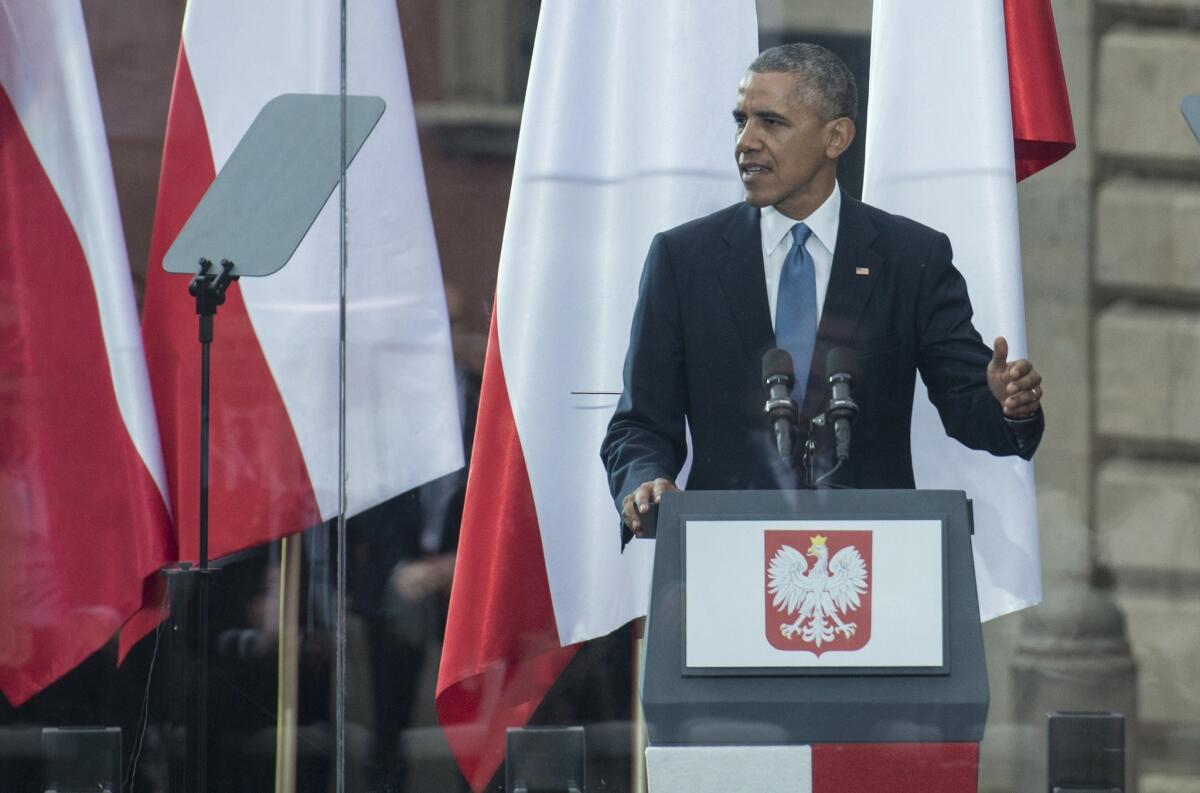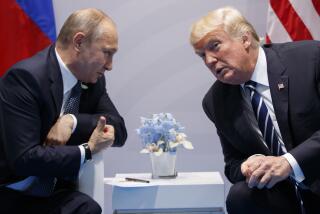Russian saber-rattling has Eastern Europe craving NATO protection

- Share via
Red lines haven’t been kind to President Obama. When he warned Syria’s Bashar Assad against using chemical weapons, Assad used them anyway. When he warned Russia against seizing Crimea, Vladimir Putin went ahead and annexed the place.
But there was Obama in Poland this week, solemnly reaffirming the biggest and brightest red line in U.S. foreign policy: the 1949 North Atlantic treaty that commits the United States to defending its allies in Europe against any outside threat — which these days, once again, means Russia.
The U.S. commitment to its allies, Obama said, is “rock solid.” To underscore the commitment, he proposed a $1-billion “European Reassurance Initiative,” a package of beefed-up military exercises and training programs.
So were the allies reassured? Not entirely.
Their worries are understandable. Putin has pointed to the population of ethnic Russians in Estonia — about one-quarter of the little republic’s 1.3 million people — and declared that he feels a duty to protect them, just as he has “protected” Russian-speakers in Ukraine. And Obama’s “reassurance initiative” was a little thin on details.
The Poles and other Eastern Europeans have always felt a little like second-class members of the North Atlantic Treaty Organization, thanks to a 1997 promise the alliance made to Russia (in a previous act of “reassurance”) that it wouldn’t station permanent forces in the East as long as conditions remained peaceful.
And there’s a split in the alliance over how hard to push against Putin. NATO’s Eastern members, who feel most vulnerable to Russia, favor a tougher stance than its Western members, led by Germany and France.
“For the Poles and the Baltic states, what happened in Ukraine was a fundamental change in the post-Cold War security system. It was Russia using force to change borders,” said Ivo Daalder, the chief U.S. representative to NATO during Obama’s first administration.
The split is the most recent of many divides between NATO’s newest members, the hawkish “New Europe” that then-Defense Secretary Donald Rumsfeld praised when it supported the U.S. invasion of Iraq in 2003, and the dovish “Old Europe” of the West.
And Obama? “He’s in the middle, trying to find a consensus,” noted Daalder, now president of the Chicago Council on Global Affairs. “He’s having to relearn one of the basic debates we had during the Cold War: How do you deter and reassure without provoking?”
It wasn’t supposed to be this hard. When NATO grew from 12 members to 26 in the euphoria following the end of the Cold War, conflict with Russia seemed far-fetched. NATO enlargement was intended to make a clash even less likely, since no rational Russian leader would want to tangle with the Western alliance
In 2009, NATO didn’t even have a contingency plan for the defense of Estonia, Daalder said. (It does now.)
But the Estonians and their neighbors are nervous enough that they want something more: Western troops stationed permanently on their soil. Currently, modest numbers of NATO forces, mostly air and naval units, rotate in and out of the region, but only on a short-term basis.
Establishing a large and permanent NATO troop presence next door to Russia is still unlikely, if only because no country is eager to bear the cost. But here are three ways a stronger Western presence in Eastern Europe could be made more reassuring at a reasonable price.
First, longer deployments could be instituted, even if they’re not quite permanent. “Just say the troops will be there as long as the situation requires,” Daalder suggested. “Until Russia pulls out of Crimea, for example.”
Second, make the deployments small but still visible. “A modest detachment of special forces would make the point,” said retired Adm. James Stavridis, a former NATO commander now at the Fletcher School of Law and Diplomacy at Tufts University. The host countries should be asked to pay much of the cost, he added.
Third, address the Eastern Europeans’ non-military needs. “What the Baltic states need most may be intelligence and police training,” one U.S. official told me. “The military reassurance package doesn’t really address the kind of Russian operations we’ve seen in Ukraine.”
Meanwhile, the reminder from Russia that NATO’s mutual-defense obligation isn’t hypothetical means the alliance’s days of expansion are almost surely over for the time being. That’s bad news for Montenegro (the next country in line) and for Ukraine and Georgia (stuck on the waiting list).
And things aren’t likely to change soon. The last big confrontation between Russia and the West, let’s remember, lasted a little more than 40 years.
This isn’t another Cold War. The United States and Russia aren’t threatening each other with nuclear weapons, and that’s a big difference. And the conflict is mostly local, confined to parts of the old Soviet Union that Putin wants to bring into his sphere of influence.
But Obama’s “Reassurance Initiative,” despite its missing pieces, is a cautious first step toward a strategy to make sure Russia knows that NATO will keep its most basic commitment: the defense of its members.
In fact, there’s a word left over from the Cold War that pretty well describes what the president is trying to do: “containment.”
For anyone who remembers history, that might be reassuring.
More to Read
A cure for the common opinion
Get thought-provoking perspectives with our weekly newsletter.
You may occasionally receive promotional content from the Los Angeles Times.







